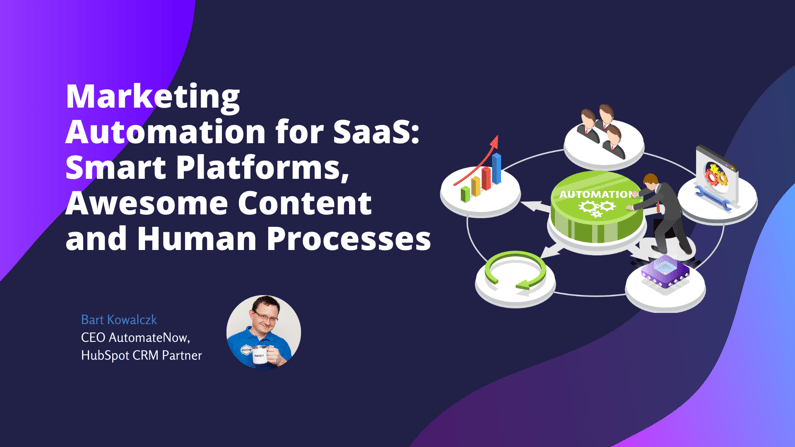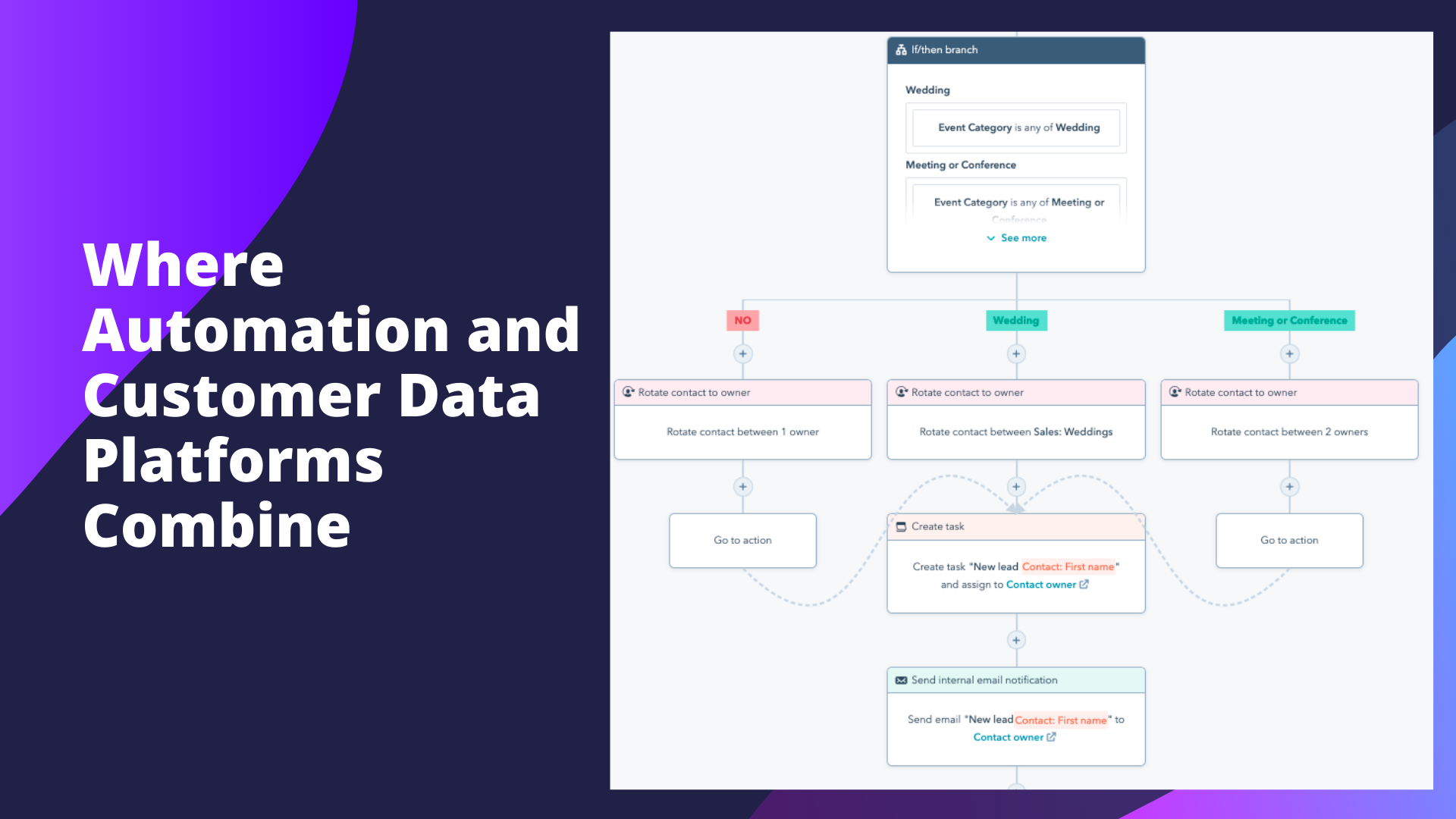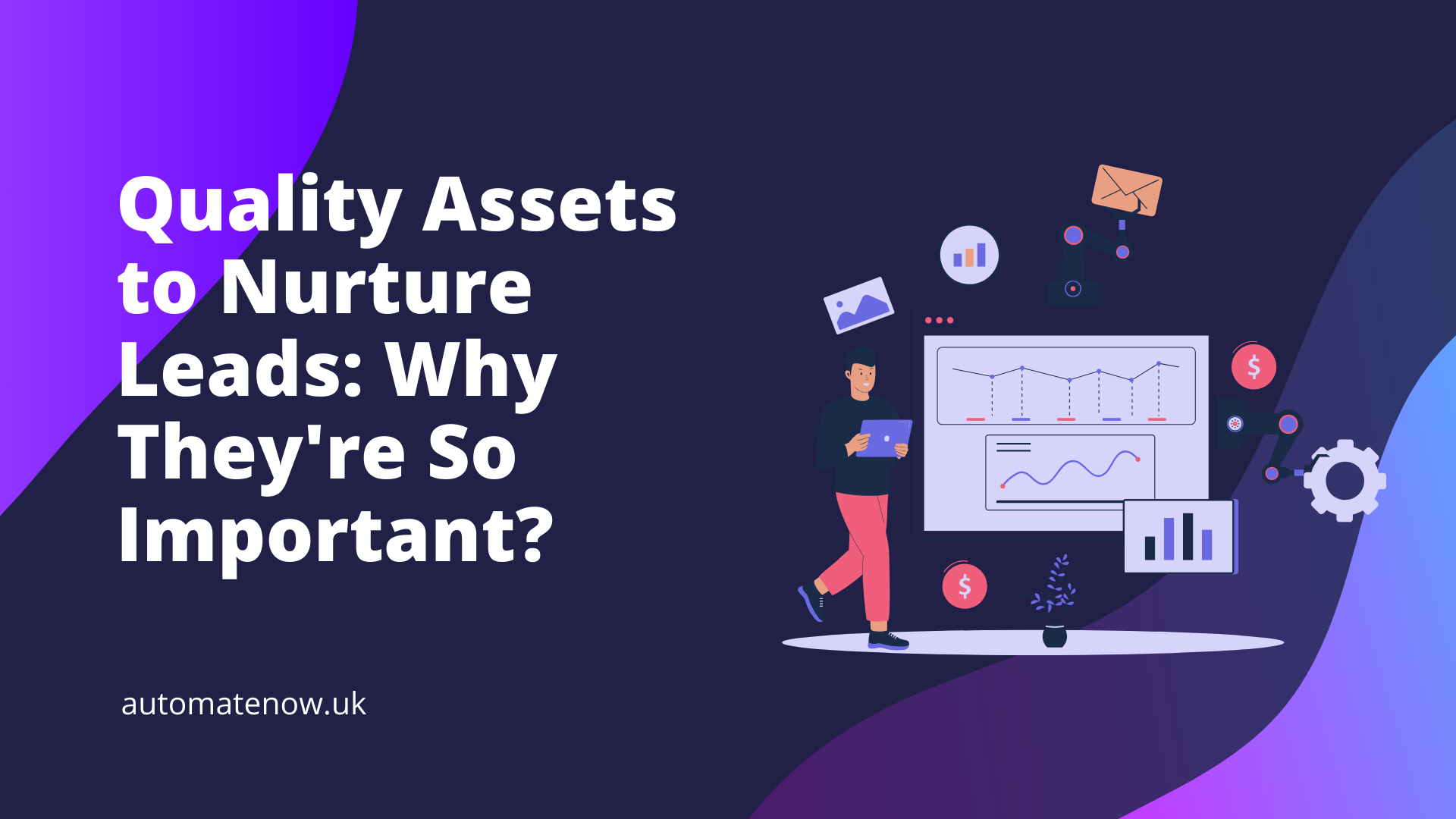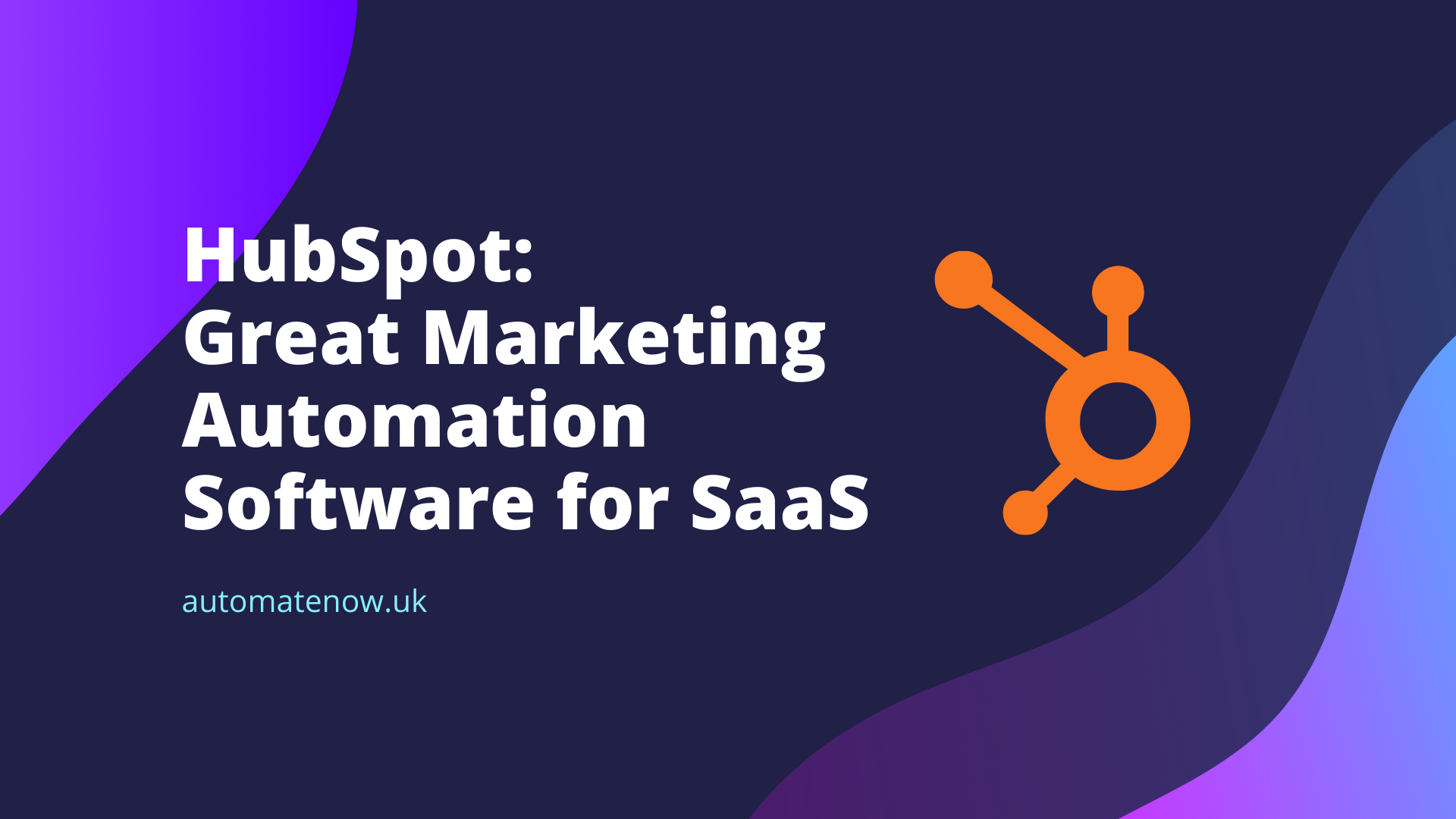Marketing Automation for SaaS: Smart Platforms, Awesome Content and Human Processes
What exactly is marketing automation, and why is it so critical for SaaS companies, specifically? - Simply put, marketing automation is the process of using software and technologies to help savvy marketing teams automate repetitive tasks.

That's the super basic answer, of course - and we both know you're here for more than that! Yes, automating repetitive tasks is a huge time saver, but SaaS marketing automation refers to so much more. What about creating a dynamic website that adapts to your prospect's country and culture, or an email marketing campaign that feels truly personalised and can be sent out 24/7?
These smart CRM automations not only help to streamline your customer's sales journey, but that time back in your diary can now be spent on the human-to-human work that creates an incredible customer experience, delights your clients, and could never be replicated by a machine.
In this article, we're diving into the fascinating world of marketing automation tools, systems, and strategies to help every SaaS company see the remarkable growth they deserve.
We'll cover:
- Jargon Buster! A Marketing Automation Cheat Sheet
- The Benefits of Marketing Automation for SaaS: The Tools You Need
- Getting Started with Smart Marketing Automation Tools for Your SaaS Business
- Example Workflows: Where Automation and Customer Data Platforms Combine
- Common Marketing and Sales Automation Mistakes
- Quality Assets to Nurture Leads: Why They're So Important
- HubSpot: Great Marketing Automation Software for SaaS
Jargon Buster! An All-in-One Marketing Automation Cheat Sheet
Before we jump in, let's look at some key terms that lots of marketers take for granted, that could be confusing for those who haven't met these phrases yet.
Marketing Automation
![]() This could be any marketing task at all - from sending emails and text messages to creating leads in a CRM, to nurturing prospects with content over time - that you set up to run automatically. Once someone pulls a trigger on the activity, your marketing automation and data-gathering tools kick in, and do the work of sending things out for you. More on that later.
This could be any marketing task at all - from sending emails and text messages to creating leads in a CRM, to nurturing prospects with content over time - that you set up to run automatically. Once someone pulls a trigger on the activity, your marketing automation and data-gathering tools kick in, and do the work of sending things out for you. More on that later.
Marketing Stack
Sometimes called a "martech stack", or a "marketing technology stack", when people talk about marketing stacks, they're just referring to a set of marketing tools, tech, and platforms that marketing professionals use in their daily roles to automate, deliver, measure, and improve their efforts.
Email Marketing
Don't look at us like that! Yes, you might think email marketing is a basic term, but we see lots of folks misinterpreting what this vital B2B SaaS marketing tool is all about.
In our context, this term broadly refers to any deliberate emails that you send out to tell people about your SaaS products or services, nurture prospects, and forge relationships. It's a great way of engaging inbound leads, warming up prospects that might have gone cold, and so much more. With great email marketing automation, every message you send takes on the role of a 24/7 sales rep, when you use the right tools like HubSpot workflows and sequences.
Omnichannel Marketing
If "omni" means all, and channel refers to all the ways that your customers could engage with you (think email, LinkedIn, website, telephone call, SMS, chatbot, Facebook, you name it...), then this term means providing a consistent experience across every marketing and sales platform you use.
As any great SaaS marketer knows, your marketing activities have to offer your prospect a streamlined, immediately recognisable experience.
Studies show that, especially for SaaS industry sales and marketing, your prospect needs somewhere between 7-9 touchpoints before they're ready to engage with your team.
No matter which channel someone uses to engage with you, to make sure you come across as trustworthy, every touchpoint has to feel and work just like the others. In omnichannel marketing, consistency is king.
Customer Lifecycle
We cover this in our article "B2B SaaS Lead Generation Tactics and Tips for Increased Sales", but in a nutshell, "customer lifecycle" - sometimes known as the "buyer's journey" means all the steps that someone goes through when they become a customer, which are: reach, acquisition, conversion, retention, and loyalty.
For a proper look at this term, check out this HubSpot article for a thorough explanation - and some great tips on how to manage that lifecycle for more sales from your inbound and outbound marketing.
Customer Data
![]() Emails, names, numbers, addresses -pretty much any info that your business collects about your customer or audience is considered customer data. For what we hope are obvious reasons, it's darned important intel to have. How could you put together a comprehensive marketing strategy or create a personalised sequence for a specific target audience within the SaaS space if you didn't have any valuable, detailed intel?
Emails, names, numbers, addresses -pretty much any info that your business collects about your customer or audience is considered customer data. For what we hope are obvious reasons, it's darned important intel to have. How could you put together a comprehensive marketing strategy or create a personalised sequence for a specific target audience within the SaaS space if you didn't have any valuable, detailed intel?
And we promise we're not just sharing other articles, but that cracking read above that's all about Lead Generation Tactics and Tips for Increased Sales? Yep, it's got some vital info in there about the importance of first-party data and why it's so essential if you want to sell more effectively.
Conversational Marketing
Our last jargon-busting section here is all about having authentic conversations. What do we mean? Well, when marketers use this term, we're talking about delivering as many one-to-one interactions as you can across a variety of channels, in real-time.
At its core, this approach to automated marketing is about making every possible engagement feel like a conversation with a real person.
By thinking creatively about social media automation, workflow automation, personalised content marketing, or any of the other tactics and tools available, making each interaction more human is a crucial part of any SaaS company's digital marketing efforts.
The Benefits of Automation for SaaS: The Tools You Need
Let's talk for a moment about why having the right marketing processes in place is so important for SaaS companies.
Marketing automation is indispensable for any SaaS company, because any subscription-based model relies on continuously generating and converting net-new leads.
Why is that approach so essential? Well, it's one of the only ways to drive sustainable growth at scale.
Manual marketing alone often can't keep up with the demands of efficiently acquiring the sheer volume of customers needed to increase revenue month on month... But with the right marketing automation tactics, you can give your team a competitive advantage by systematising fairly repetitive activities like lead capture, qualification, and follow-up.
This empowers SaaS companies to dedicate more time to high-level creative planning and customer care efforts, mapping a customer journey that ultimately delights subscribers and minimises churn.
In particular, the best SaaS marketing strategies leverage automation tools to:
- Educate and nurture prospects by delivering targeted, relevant content over time that moves leads down the funnel with things like email automation
- Avoid overwhelming potential customers with irrelevant messages or offers that don't address their current stage or interests
- More efficiently and accurately qualify inbound leads based on engagement data and automatically progress them through workflows tailored to their needs
- Increase overall productivity and lead generation by removing repetitive administrative tasks, enabling staff to focus on more strategic initiatives
Your overarching objectives should be:
- Empowering teams to efficiently create and manage more new leads than manual efforts alone
- Nurturing those prospects with personalisation to encourage conversion
- And ultimately driving business growth, customer lifetime value, and retention.
By handling lead scoring, list segmentation, email sequencing, and other labour-intensive activities, automation is the solution for SaaS companies who want to create their own competitive advantage.
Getting Started with Smart Marketing Automation Tools for Your SaaS Business
When you first start exploring how to leverage automation for your SaaS, begin by mapping out your ideal buyer's journey. Specifically for SaaS, this is one of the best tools you can use to take your marketing automation to the next level.
We recommend you carefully analyse your current content and touchpoints, whether that's emails, web pages, or chatbot conversations, everything you're putting out there is an opportunity to convert your prospects, and make them long-term customers.
You should also review past moments and interactions that led to you closing deals...and, while it feels icky, you should also examine where your lead dropped out of the pipeline! Why was the sale lost? What needed to be done differently?
While lots of marketing agencies out there would offer to help with this (for a pretty price tag, too!) this is an exercise that SaaS companies need to do for themselves. Really consider your client, your marketing channels, your social media marketing - literally every experience a customer will have with you.
It's a bit like going on a treasure hunt: this work reveals the key triggers and stages that you want to think about automating with specific, nuanced sequences or workflows.
Common automation triggers include:
- Clicking on links within nurture emails multiple times, indicating interest
- Downloading gated premium assets like ebooks, tip sheets, or templates
- Initiating conversations via live chat or site messagin=g
Still a bit confused? Let's look at a another marketing automation example:
- Your trigger is set as 'multiple clicks on a nurture email'
- A prospective customer clicks on a nurture email several times
- Once that trigger kicks in (hello, email marketing automation!) any number of tools can take over
- For example, you could automatically add them to a relevant multi-touch sequence about that topic to provide more relevant information, depending on their interests (which you gauge from their interactions and first-party data)
Neat, huh? While a lot of marketing automation efforts are quite linear, if you get creative with SaaS marketing automation software, you could potentially engage a customer in multiple interactions from a single trigger - provided you don't overwhelm them. For example:
- If a contact requests a demo via live chat, you could automatically notify sales to prioritise a speedy follow-up,
- At the same time, you could also add that lead to sequences that educate them about key product benefits, even if they don't proceed after the demo itself.
Example Workflows: Where Automation and Customer Data Platforms Combine
Feel like you're getting it now? Awesome! Let's look at some more of the best marketing automation features from a workflow perspective.
- A prospect signs up for a webinar?
- Automate and send a personalised WhatsApp or SMS confirming their spot immediately (remember - conversational marketing and sales go hand in hand!)
- Re-engage contacts who have been inactive after a certain time period!
- Re-enter them into a nurturing email campaign that matches their interests using the right marketing automation tools
- Got a new user on your platform for a free plan or trial?
- Set up automated 30-, 60-, and 90-day sequences that guide new free trial users through onboarding and core product education
- Prospects downloading your premium assets?
- Create workflows to nurture these leads, and think about automating emails that share additional eBooks, ROI calculators, and any other related content over a series of 4-6 messages
Common Marketing and Sales Automation Mistakes
While marketing automation tools for SaaS businesses unlock huge opportunities, they can also negatively impact marketing campaigns, customer experience, and otherwise sabotage your customer journey. What are the key things to watch out for and avoid? Glad you asked!
Sending the same content to everyone
Don't you just hate it when you get the same vanilla, spammy content as everyone else out there? You know what we mean - the emails that have nothing to do with your interests, the ones that show up with bland messages and truly terrible stock photos (or worse, those 'work' graphics where people are touching holographic screens for unknown reasons). Whatever you do when it comes to automation, make sure you put effort into thinking about your prospects - their needs and interests, not what's easiest for you.
Not having enough quality content
You've probably gathered that when it comes to content, quality trumps quantity every time - but one of the risks that SaaS marketers could run is not having a decent quantity of quality content. Take the time to develop and create a suite of interesting infographics, content pillars, SME interviews, videos; you name it. By putting in processes to capture content throughout each month or quarter, you alleviate the burden of having to generate new assets when there's a sudden sales dip. If you're using AI as a single-step process to generate that content, well, the market is going to give you what you deserve.
Not understanding your buyer personas and their needs/interests
This mistake is going to cost you, big time! Understanding your customers is the number one priority when it comes to successful selling. If you don't understand your customer, it doesn't matter how great your email marketing for saas and marketing automation is, those thoughtfully written, intelligent messages could go to the inbox of someone who doesn't need your service! Not only does trying to sell to someone who doesn't need what you have feel like pushing water up a hill, you're wasting valuable time chasing leads that won't close, when you could be fostering great relationships with people who do need what you have.
Focusing on your customer's needs should be your number one priority. If it isn't, change that.
Sending content at the wrong time
Beyond sending out bland, porridge-flavoured content to people who aren't interested, you could be committing another sin - sending content at the wrong time! You know what people probably don't need on a hectic Monday morning when they're only halfway through their coffee and their eyes aren't open yet?
Another dull, irrelevant sales email that clogs up their inbox and irritates them. Look to the data you do have, instead. When are your prospects opening your emails? For some folks that could be 4pm on a Friday, for others it might be 2pm Tuesday. Gather some insights, do some testing, and go from there.
Not writing in a way that’s engaging, accessible, or readable
We've established just how much content is a crucial part of every SaaS marketing strategy, right? While your content might look sharp and jazzy from a visual perspective, we've got another angle to consider - can people actually read and engage with what you've written?
B2B companies - and SaaS organisations especially - are notorious for filling their content with jargon, lofty words, and other terms that leave people confused about what you're really telling them.
Look, it's great if you know what a "hybrid synergistic management-driven capacity streamlining solution" is, but if your prospect just needs something that helps them manage their people's workload better, why not just say that?
Quality Assets to Nurture Leads: Why They're So Important
High-quality, differentiated content assets are essential. So why do they seem like they're a low priority when it comes to marketing for SaaS?
Tailored to each stage of the buyer's journey, incredible content is absolutely essential for marketing automation success:
The best SaaS marketing automation strategies segment their content for each stage of the buyer's journey - particularly if you're looking to nail inbound marketing, this is where your content becomes a magnet.
Whatever your approach to marketing automation, when it comes to your content, focus on clarity, accuracy, relevance, and depth, so you earn an expert reputation and build trust.
Awareness Stage
Your goal with this content? Attract and educate new contacts. Consider creating:
- Blog posts
- eBooks
- Infographics
- Tip sheets
Consideration Stage
This quality content should be carefully crafted to actively qualify and nurture leads. Think about:
- Product demo videos
- free trial sign-up forms
- ROI calculators
- Interactive quizzes
Decision Stage
This content should address final questions and objections for key decision-makers. Don't leave your sale to chance!
- Case studies
- Analyst reports
- Customer testimonials
- Product tour videos
Taking the time upfront to create well-written, visually engaging assets that cover relevant topics is vital.
Not only will your conversion rates soar, but you'll also avoid lots of common content mistakes, like irrelevance, information overload, and subscriber disengagement.
HubSpot: Great Marketing Automation Software for SaaS
With everything we've talked about so far, hopefully it's evident that finding the right automation software for SaaS companies is crucial to your success.
Now, we're maybe a little bit biased, but we do think that HubSpot is the most effective marketing automation platform out there. Yes, lots of other tools can help, but a platform like HubSpot really does give you a headstart when it comes to robust marketing automation. And despite what some software companies or SaaS marketing agencies say, you don't need 20 SaaS marketing automation tools when you can use just one!
Not only does HubSpot help you to build sequences and workflows triggered by those all-important prospect actions, but it also enables you to automate targeted follow-ups, such as emails, SMS messages, notifications, chatbot nudges, and more.
And, remembering the importance of quality content, HubSpot also has a suite of tools to help, like progressive web apps, multi-language website creation (essential for global markets!), smart CTAs, and more.
As an all-in-one marketing automation platform, HubSpot also leverages its Smart CRM data, so you can send tailored content experiences, based on factors like location and lead lifecycle stage.
For example, if you want to kickstart success, new HubSpot users can leverage pre-built workflow templates for common lead nurturing scenarios.
In HubSpot, you can use existing templates that are tailored to your prospects depending on which stage of the buyer's journey they're in - whether that's the awareness, consideration, or decision stage.
Once you've laid a solid foundation, you can then iteratively test how your contacts interact with messages, using automation and data to continually optimise every touchpoint - boosting your conversion rates and delighting your customers - or, as we like to call it, doing business the human to human (H2H) way!
In Summary
As we've seen - marketing automation tools are critical for SaaS companies to efficiently generate and convert new leads at scale. By automating repetitive tasks like lead scoring and email sequencing, SaaS marketers get more time back in their diaries for creative, empathetic high-level planning and customer care.
Your goal with automation is to empower teams to manage more new leads than manual efforts alone, nurture prospects to encourage conversion, and ultimately drive growth and retention.
To leverage automation, start by first mapping the ideal buyer's journey, then analyse your current content and touchpoints that have either resulted in closed deals or a lost sale. This reveals key triggers and stages to automate, like multiple clicks on emails or downloading premium assets. Workflows, sequences and more can then provide targeted follow-ups via email, SMS, chatbots, and so on.
Remember, your high-quality, stage-specific content assets are essential for automation success! Content should aim to attract and educate prospects, actively nurture leads, and address final objections, so continually test and optimise your content based on engagement data to boost conversion.
Above all, if all of this sounds overwhelming, don't worry. While automation tools can help, getting used to them can take some time - and having someone in your corner to help you discover the best marketing automation solution can make all the difference. You can book a demo with us here - and in the meantime - happy automating!








